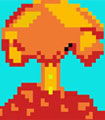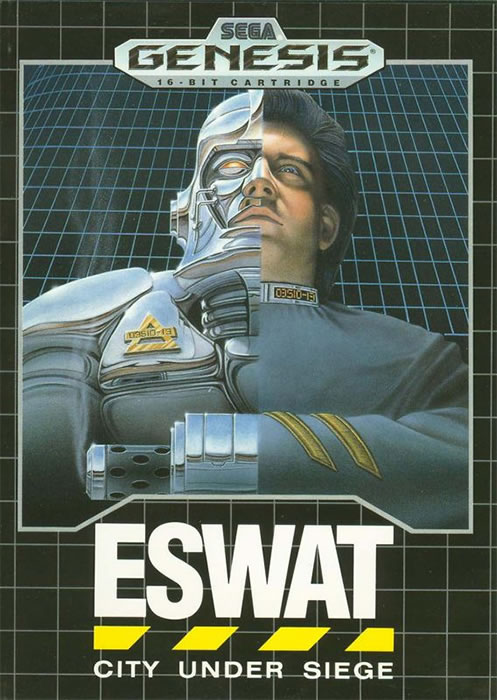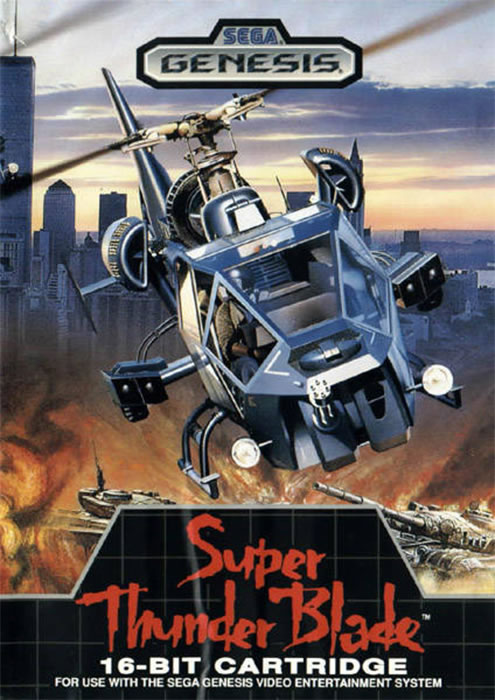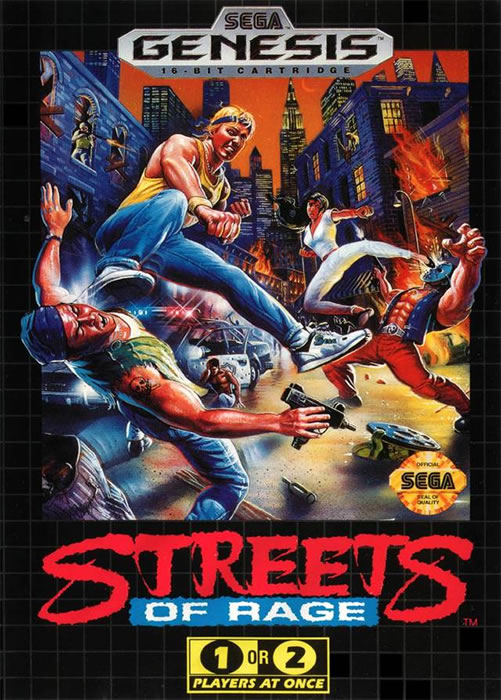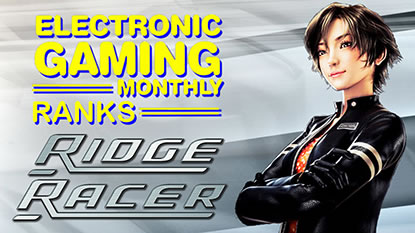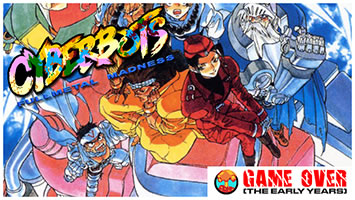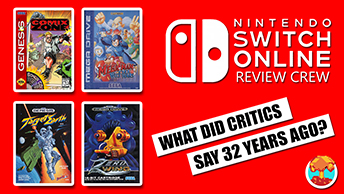- CLASSIC MAGAZINES
- REVIEW CREW
A show recapping what critics thought back
when classic games first came out! - NEXT GENERATION'S BEST & WORST
From the worst 1-star reviews to the best
5-stars can offer, this is Next Generation! - NINTENDO POWER (ARCHIVE)
Experience a variety of shows looking at the
often baffling history of Nintendo Power! - MAGAZINE RETROSPECTIVE
We're looking at the absolutely true history of
some of the most iconic game magazines ever! - SUPER PLAY'S TOP 600
The longest and most ambitious Super NES
countdown on the internet! - THEY SAID WHAT?
Debunking predictions and gossip found
in classic video game magazines! - NEXT GENERATION UNCOVERED
Cyril is back in this spin-off series, featuring the
cover critic review the art of Next Generation! - HARDCORE GAMER MAGAZING (PDF ISSUES)
Download all 36 issues of Hardcore Gamer
Magazine and relive the fun in PDF form!
- REVIEW CREW
- ELECTRONIC GAMING MONTHLY
- ELECTRONIC GAMING MONTHLY RANKS
From Mario to Sonic to Street Fighter, EGM
ranks classic game franchises and consoles! - ELECTRONIC GAMING MONTHLY BEST & WORST
Counting down EGM’s best and worst reviews
going year by year, from 1989 – 2009! - ELECTRONIC GAMING BEST & WORST AWARDS
11-part video series chronicling the ups and
downs of EGM’s Best & Worst Awards!
- ELECTRONIC GAMING MONTHLY RANKS
- GAME HISTORY
- GAME OVER: STORY BREAKDOWNS
Long-running series breaking down game
stories and analyzing their endings! - A BRIEF HISTORY OF GAMING w/ [NAME HERE]
Real history presented in a fun and pithy
format from a variety of game historians! - THE BLACK SHEEP
A series looking back at the black sheep
entries in popular game franchises! - INSTANT EXPERT
Everything you could possibly want to know
about a wide variety of gaming topics! - FREEZE FRAME
When something familiar happens in the games
industry, we're there to take a picture! - I'VE GOT YOUR NUMBER
Learn real video game history through a series
of number-themed episodes, starting at zero! - GREAT MOMENTS IN BAD ACTING
A joyous celebration of some of gaming's
absolute worst voice acting!
- GAME OVER: STORY BREAKDOWNS
- POPULAR SHOWS
- DG NEWS w/ LORNE RISELEY
Newsman Lorne Riseley hosts a regular
series looking at the hottest gaming news! - REVIEW REWIND
Cyril replays a game he reviewed 10+ years
ago to see if he got it right or wrong! - ON-RUNNING FEUDS
Defunct Games' longest-running show, with
editorials, observations and other fun oddities! - DEFUNCT GAMES QUIZ (ARCHIVE)
From online quizzes to game shows, we're
putting your video game knowledge to the test!- QUIZ: ONLINE PASS
Take a weekly quiz to see how well you know
the news and current gaming events! - QUIZ: KNOW THE GAME
One-on-one quiz show where contestants
find out if they actually know classic games! - QUIZ: THE LEADERBOARD
Can you guess the game based on the classic
review? Find out with The Leaderboard!
- QUIZ: ONLINE PASS
- DEFUNCT GAMES VS.
Cyril and the Defunct Games staff isn't afraid
to choose their favorite games and more! - CYRIL READS WORLDS OF POWER
Defunct Games recreates classic game
novelizations through the audio book format!
- DG NEWS w/ LORNE RISELEY
- COMEDY
- GAME EXPECTANCY
How long will your favorite hero live? We crunch
the numbers in this series about dying! - VIDEO GAME ADVICE
Famous game characters answer real personal
advice questions with a humorous slant! - FAKE GAMES: GUERILLA SCRAPBOOK
A long-running series about fake games and
the people who love them (covers included)! - WORST GAME EVER
A contest that attempts to create the worst
video game ever made, complete with covers! - LEVEL 1 STORIES
Literature based on the first stages of some
of your favorite classic video games! - THE COVER CRITIC
One of Defunct Games' earliest shows, Cover
Critic digs up some of the worst box art ever! - COMMERCIAL BREAK
Take a trip through some of the best and
worst video game advertisements of all time! - COMIC BOOK MODS
You've never seen comics like this before.
A curious mix of rewritten video game comics!
- GAME EXPECTANCY
- SERIES ARCHIVE
- NINTENDO SWITCH ONLINE ARCHIVE
A regularly-updated list of every Nintendo
Switch Online release, plus links to review! - PLAYSTATION PLUS CLASSIC ARCHIVE
A comprehensive list of every PlayStation
Plus classic release, including links! - RETRO-BIT PUBLISHING ARCHIVE
A regularly-updated list of every Retro-Bit
game released! - REVIEW MARATHONS w/ ADAM WALLACE
Join critic Adam Wallace as he takes us on a
classic review marathon with different themes!- DEFUNCT GAMES GOLF CLUB
Adam Wallace takes to the links to slice his way
through 72 classic golf game reviews! - 007 IN PIXELS
Adam Wallace takes on the world's greatest spy
as he reviews 15 weeks of James Bond games! - A SALUTE TO VAMPIRES
Adam Wallace is sinking his teeth into a series
covering Castlevania, BloodRayne and more! - CAPCOM'S CURSE
Adam Wallace is celebrating 13 days of Halloween
with a line-up of Capcom's scariest games! - THE FALL OF SUPERMAN
Adam Wallace is a man of steel for playing
some of the absolute worst Superman games! - THE 31 GAMES OF HALLOWEEN
Adam Wallace spends every day of October afraid
as he reviews some of the scariest games ever! - 12 WEEKS OF STAR TREK
Adam Wallace boldly goes where no critic has
gone before in this Star Trek marathon!
- DEFUNCT GAMES GOLF CLUB
- DAYS OF CHRISTMAS (ARCHIVE)
Annual holiday series with themed-episodes
that date all the way back to 2001!- 2015: 30 Ridiculous Retro Rumors
- 2014: 29 Magazines of Christmas
- 2013: 29 Questionable Power-Ups of Christmas
- 2012: 34 Theme Songs of Christmas
- 2011: 32 Game Endings of Christmas
- 2010: 31 Bonus Levels of Christmas
- 2009: 30 Genres of Christmas
- 2008: 29 Controls of Christmas
- 2007: 34 Cliches of Christmas
- 2006: 33 Consoles of Christmas
- 2005: 32 Articles of Christmas
- 2004: 31 Websites of Christmas
- 2003: 29 Issues of Christmas
- 2002: 28 Years of Christmas
- 2001: 33 Days of Christmas
- NINTENDO SWITCH ONLINE ARCHIVE
- REVIEW ARCHIVE
- FULL ARCHIVE
Nintendo Switch Online: 1990s Critics Review Streets of Rage, ESWAT & Super Thunder Blade on Genesis
Did you know that it has been 134 days since a Genesis game was added to the Nintendo Switch Online service? Thankfully, that drought ends today with three classic 16-bit games straight from Sega's vault, including the shoot ‘em up sequel Super Thunder Blade, the action-packed ESWAT: City Under Siege and the seminal two-player beat ‘em up Streets of Rage. That's exciting news, but are any of these games actually worth playing? To answer that question, I decided to flip through the pages of Electronic Gaming Monthly, Mean Machines Sega, Mega Play and more classic magazines to see what the critics said back when these games first came out. Get ready for another love it or hate it episode of Nintendo Switch Online Review Crew!
Landing somewhere between NARC and RoboCop is ESWAT: City Under Siege, the 1990 action game starring Duke Oda, a beat cop who spends seven stages slowly becoming a heavily-armored killing machine. Now, if all of this sounds familiar, it might be because this is a loose adaptation of Cyber Police ESWAT, which hit arcades just one year earlier. That was basically a futuristic take on Sega's classic game Shinobi, and while this Genesis spin-off still has echoes of the arcade hit, it has different levels, weapons and bosses. This is one of those Sega games that shows up in pretty much every Genesis collection, whether you like it or not. Let's see where the critics landed.
We might as well start with Electronic Gaming Monthly, who is actually on the low end of the scale this time around. In their 1991 Video Game Buyers Guide (of all places), EGM gave ESWAT an average score of 7.5 out of 10. That may not sound too bad, but it doesn't tell the full story. This is one of those examples where everybody is on the same page, except for one editor. For example, Martin gave the action game a 7 out of 10, arguing that “ESWAT isn't bad, but it isn't a very intense or spectacular game either. The graphics and music are adequate, but the game plays way too slow for me. Controls are awkward and the power-ups lame.” Sushi-X, on the other hand, strongly disagreed, giving it a 9: “Strap on your weapon, pin on your badge and go get em! Non-stop action as a futuristic law enforcer in a city gone berserk. Great action including an evolving mobile suit and flight pack make things interesting. No Batman? Get this one.”
When it comes to the lower scores, we could talk about Raze, who gave it a 72%. Or maybe we could look at Mega Play, who rounded down, giving the game a 7 out of 10. But look, those aren't worth our time, because the only low score worth talking about comes from Game Zone, who gave ESWAT a score of, get this, 1 out of 6. “Highly unoriginal beat ‘em up that looks as dated as a very old thing. No plot, just a fair workout for your trigger finger.” It looks “as dated as a very old thing”? Yup, nailed it, Mr. Professional Writer.
Now that we've got the outliers out of the way, let's start our ascent up the review scale. Sega Power ended up giving ESWAT a score of 78%, three points higher than EGM. The Games Machine went a couple of ticks better, going with an 80%. And then there's Mean Machines and their 87%. Now, we could talk about the 89% found in Sega Pro, but I would rather check in with Ace and their ridiculous one-thousand-point scale. Giving the action game a score of 895, Ace concluded that “ESWAT is a bang up to date arcade game and its Mega Drive implementation is kissing close to the coin-op original. Although ESWAT is based around a fairly simple game design, the gameplay is sufficiently varied and challenging to keep you going until you have beaten the last of the six crime bosses. That is likely to take a long time to do.”
As we continue on, we have Video Games & Computer Entertainment going as high as a 9 out of 10, making it one of their best-reviewed games of 1990. Mean Machines Sega liked it even more than their flagship publication, going as high as a 92%. That's the same score we saw from MegaTech in their first issue. But if you're looking for the highest score, then look no further than Computer & Video Games, who went all the way up to a 93%. “Basically, ESWAT is Super Shinobi with all sorts of mega guns and hulking great suits of cyber-armor. But even though it's not very original, it's one hell of a game. The sprites and backdrops are excellent, with brilliant parallax scrolling scenery, and all manner of beautifully animated baddies to blow into oblivion. The difficulty level is nicely balanced to draw you into the game, and it doesn't take long to get to level four, but from there on things get pretty tough, and it takes quite some practice to crack the remaining four levels. And even if you get through the game, there are a further three difficulty levels to challenge you, adding extra lasting appeal. If you're after a slick and highly playable arcade game, ESWAT is the one to go for.”
For me, ESWAT has never really clicked. I love some of the ideas and I think the world building is pretty cool, but I largely agree with EGM on this one. Don't get me wrong, Game Zone is crazy, so don't lump me in with those haters. But even with that outlier dragging the score down, the overall average still remains a 79%. With so many outlets praising the game, I say give it a shot. I may not love it, but you might.
When the Genesis launched in 1989, Sega knew they had one ace card up their sleeve – their treasure trove of hugely popular arcade games. This strategy was obvious in the early days, when the system launched with high-profile ports of arcade games like Altered Beast, Space Harrier II and Sega's critically-acclaimed version of Ghouls ‘N Ghosts. 36 years later, I wouldn't blame you if you lumped Super Thunder Blade into the list of arcade ports, but it's not. Instead, it's a console sequel to the 1987 arcade game Thunder Blade, showing that the Genesis could do more than just ports. But did that translate to high marks from the critics? Let's find out.
We're once again going to start with Electronic Gaming Monthly, who ended up giving Super Thunder Blade an average score of 6 out of 10. To put that score into perspective, this shooter ended up being EGM's worst-reviewed Genesis launch game. When Steve reviewed it, he gave it a 5 out of 10, arguing that “Super Thunder Blade just isn't what a 16-bit game should be. It's not offending, but the graphics, while detailed, don't move in smooth progression from the background to the foreground. The worst thing about Super Thunder Blade, however, is how it controls, with poor response that is slow and sluggish and makes the game tedious.” Jimm strongly disagreed, raving about the “Awesome graphics! Harder than the arcade or 8-bit versions of Thunder Blade, but also a lot better. The controls are sluggish, but the graphics more than make up for any minor problems in play. Super Thunder Blade makes the 8-bit Thunder Blade look like a 2600 game.”
If you think EGM's 6 out of 10 is a bad score, then buckle up, because this is going to be a bumpy ride. The next step down is Mean Machines Sega, who ended up giving the shooter a sub-optimal score of 49%. And as long as we're freefalling, we might as well smack into Sega Force, who went with a 37%. “Unfortunately, the scenario and artillery's the only slightly impressive thing about this sham of a game. The 3D effect's diabolical and the action so tedious you'd get as much enjoyment reading a copy of certain other Sega mags. Quite why anyone would want this is too mind-numbing to contemplate. Avoid like the plague.”
That's harsh, but it's nothing compared to the reigning champ of low scores. Let's quickly check in with Game Zone, who once again gave a Genesis game a score of 1 out of 6. “Ancient game, with loads of really blocky 3D graphics. Sadly, it's looking it considerable age.”
For what it's worth, there were a few magazines that liked Super Thunder Blade. Raze ended up giving the game a solid 75% in their third issue, while Sega Pro went as high as an 83% in issue six. The highest score comes from ACE, and not just because they use a ridiculous one-thousand-point scale. Giving it a staggering score of 880, Ace concluded that it “captures for the first time all of the speed and enjoyment of the arcade original as you take to the skies in your attack chopper. Once again – play it loud.”
Hey, wait ... that was Nintendo's slogan. Genesis owners should be playing to the next level, where they'll be welcomed. But maybe not if they're playing Super Thunder Blade, because this game isn't great. Yes, Ace and Sega Pro liked it, but don't buy into the hype. This game was bad then and it's even worse now. The Genesis just wasn't very good at this style of 3D shooter. As a result, Super Thunder Blade earned a low overall average of only 59%. Not good.
Going into 1991, there were two unspoken truths that everybody agreed on. The first was that the Super NES would come in and once again dominate, thanks in large part to the pack-in game, Super Mario World. At the same time, many people believed that Final Fight would continue Capcom's winning streak and be the year's top beat ‘em up. But that's not how things turned out. When critics got their hands on the Super NES port of Final Fight, they complained about the missing levels, missing enemies, missing hero and, of course, the missing two-player support. They concluded that it was disappointing port. This left the door open for Sega, who burst into the room with not only the best brawler of that year, but one of the best Genesis games of all time. While not as pretty as Final Fight, Streets of Rage delivered more levels, more enemies, more heroes and, yes, full two-player support. It was a big deal.
As you might have expected, everybody loved Streets of Rage. In fact, the lowest score I could find is also the highest. No, really. The lowest score comes from ACE, who gave Streets of Rage a massive score of 885 out of 1,000. “Exceptionally easy to pick up and play, due to the instinctiveness of the control method. Streets of Rage features some of the finest music ever to grace the Megadrive, with a high-quality title theme and a tune for each level, ranging from New Jack City-style rap beats to samba and steel drum combos. Graphically, it could have packed more of a punch, but that doesn't detract from the action, and there's enough mate-impressing stuff here to sustain anybody's street cred for a good few weeks.”
Of course, ACE was the outlier, as every other magazine gave Streets of Rage a 90% or higher. This is where we see a bit of a traffic jam amongst the critics, with Mean Machines giving the game that nice round percentage, while Mega Play went with a 9 out of 10. That's the exact same score you saw over at Electronic Gaming Monthly, who reviewed Streets of Rage in the same issue as Final Fight. I think fake ninja Sushi-X sums the feud up perfectly: “Final Fight, move over!! This is the type of fighting game I've been waiting for since Fighting Street! Two players, 40 attacks, 8 levels, large bosses and music that rivals Sonic the Hedgehog, Streets of Rage is the best fighting game around.” Even Martin had to give it up for Streets of Rage: “Fighting games are not my cup of tea, but this cart totally blew me away from beginning to end. The gameplay is so good it puts all other fighting games, including Final Fight, to shame. Tons of moves and the best thing about it is the two-player mode. Funkadelic music, dude!”
As we climb the review scale, we see Sega Power go one tick higher, giving the brawler a 91%. MegaTech went one step better, giving the game a 92%. And then there's Computer & Video Games, who went with, you guessed it, a score of 93%. Frank O'Connor loved the game, going as far as to admit something embarrassing: “I almost wet myself and called the police when we first plugged in the Streets of Rage cart. The game starts up with a stupendous opening sequence and a great house remix of some fabulous oriental music. From here on, things just get better and better. The graphics are gorgeous, the sprites beautifully animated and full of life. The backdrops on certain sections are almost photographic in quality and portray a city full of disease, squalor and ninja death squads. If fast, mindless, pointless violence is your cup of tea, then get hold of Streets of Rage and have those Famicom owners wishing they'd never upgraded. Here's the game that actually makes the Fami look a bit feeble – and that's saying something.”
If you're looking for even higher scores, don't worry, I've got you covered. Sega Pro went up to a 96%. Game Zone actually gave the game a score of 5, which normally would be a perfect mark, but remember that Game Zone goes one step beyond a five-star rating, giving the best of the best the Mega Zone rating. GamePro, on the other hand, wasn't afraid to give Streets of Rage a perfect score. Going with a 5 out of 5, they concluded hat “Streets of Rage will knock you out! If you enjoy games like Double Dragon or Final Fight, you must slug it out with Streets of Rage.”
This is the perfect example of a game coming out at the perfect time. When Final Fight let everybody down, Sega really stepped in, stealing a lot of the Super Nintendo's thunder. And it wasn't a fluke, because Streets of Rage has remained one of Sega's most beloved games, which is why you aren't even remotely surprised when I tell you that the overage average score is 93%. That's the exact same average as Streets of Rage 2. Here's hoping it won't take another four years to get Streets of Rage 3 on the service.
| Publication | Scores |
|---|---|
| Computer & Video Games | 93% |
| MegaTech | 92% |
| Mean Machines Sega | 9/10 |
| ACE | 895/1000 |
| Sega Pro | 89% |
| Mean Machines | 87% |
| The Games Machine | 80% |
| Sega Power | 78% |
| Electronic Gaming Monthly | 7.5/10 |
| Raze | 72% |
| Mega Play | 7/10 |
| Game Zone | 1/6 |
| AVERAGE SCORE | 79% |
We might as well start with Electronic Gaming Monthly, who is actually on the low end of the scale this time around. In their 1991 Video Game Buyers Guide (of all places), EGM gave ESWAT an average score of 7.5 out of 10. That may not sound too bad, but it doesn't tell the full story. This is one of those examples where everybody is on the same page, except for one editor. For example, Martin gave the action game a 7 out of 10, arguing that “ESWAT isn't bad, but it isn't a very intense or spectacular game either. The graphics and music are adequate, but the game plays way too slow for me. Controls are awkward and the power-ups lame.” Sushi-X, on the other hand, strongly disagreed, giving it a 9: “Strap on your weapon, pin on your badge and go get em! Non-stop action as a futuristic law enforcer in a city gone berserk. Great action including an evolving mobile suit and flight pack make things interesting. No Batman? Get this one.”
When it comes to the lower scores, we could talk about Raze, who gave it a 72%. Or maybe we could look at Mega Play, who rounded down, giving the game a 7 out of 10. But look, those aren't worth our time, because the only low score worth talking about comes from Game Zone, who gave ESWAT a score of, get this, 1 out of 6. “Highly unoriginal beat ‘em up that looks as dated as a very old thing. No plot, just a fair workout for your trigger finger.” It looks “as dated as a very old thing”? Yup, nailed it, Mr. Professional Writer.
Now that we've got the outliers out of the way, let's start our ascent up the review scale. Sega Power ended up giving ESWAT a score of 78%, three points higher than EGM. The Games Machine went a couple of ticks better, going with an 80%. And then there's Mean Machines and their 87%. Now, we could talk about the 89% found in Sega Pro, but I would rather check in with Ace and their ridiculous one-thousand-point scale. Giving the action game a score of 895, Ace concluded that “ESWAT is a bang up to date arcade game and its Mega Drive implementation is kissing close to the coin-op original. Although ESWAT is based around a fairly simple game design, the gameplay is sufficiently varied and challenging to keep you going until you have beaten the last of the six crime bosses. That is likely to take a long time to do.”
As we continue on, we have Video Games & Computer Entertainment going as high as a 9 out of 10, making it one of their best-reviewed games of 1990. Mean Machines Sega liked it even more than their flagship publication, going as high as a 92%. That's the same score we saw from MegaTech in their first issue. But if you're looking for the highest score, then look no further than Computer & Video Games, who went all the way up to a 93%. “Basically, ESWAT is Super Shinobi with all sorts of mega guns and hulking great suits of cyber-armor. But even though it's not very original, it's one hell of a game. The sprites and backdrops are excellent, with brilliant parallax scrolling scenery, and all manner of beautifully animated baddies to blow into oblivion. The difficulty level is nicely balanced to draw you into the game, and it doesn't take long to get to level four, but from there on things get pretty tough, and it takes quite some practice to crack the remaining four levels. And even if you get through the game, there are a further three difficulty levels to challenge you, adding extra lasting appeal. If you're after a slick and highly playable arcade game, ESWAT is the one to go for.”
For me, ESWAT has never really clicked. I love some of the ideas and I think the world building is pretty cool, but I largely agree with EGM on this one. Don't get me wrong, Game Zone is crazy, so don't lump me in with those haters. But even with that outlier dragging the score down, the overall average still remains a 79%. With so many outlets praising the game, I say give it a shot. I may not love it, but you might.
| Publication | Scores |
|---|---|
| ACE | 880/1000 |
| Sega Pro | 83% |
| Raze | 75% |
| Electronic Gaming Monthly | 6/10 |
| Mean Machines Sega | 49% |
| Sega Force | 37% |
| Game Zone | 1/6 |
| AVERAGE SCORE | 59% |
We're once again going to start with Electronic Gaming Monthly, who ended up giving Super Thunder Blade an average score of 6 out of 10. To put that score into perspective, this shooter ended up being EGM's worst-reviewed Genesis launch game. When Steve reviewed it, he gave it a 5 out of 10, arguing that “Super Thunder Blade just isn't what a 16-bit game should be. It's not offending, but the graphics, while detailed, don't move in smooth progression from the background to the foreground. The worst thing about Super Thunder Blade, however, is how it controls, with poor response that is slow and sluggish and makes the game tedious.” Jimm strongly disagreed, raving about the “Awesome graphics! Harder than the arcade or 8-bit versions of Thunder Blade, but also a lot better. The controls are sluggish, but the graphics more than make up for any minor problems in play. Super Thunder Blade makes the 8-bit Thunder Blade look like a 2600 game.”
If you think EGM's 6 out of 10 is a bad score, then buckle up, because this is going to be a bumpy ride. The next step down is Mean Machines Sega, who ended up giving the shooter a sub-optimal score of 49%. And as long as we're freefalling, we might as well smack into Sega Force, who went with a 37%. “Unfortunately, the scenario and artillery's the only slightly impressive thing about this sham of a game. The 3D effect's diabolical and the action so tedious you'd get as much enjoyment reading a copy of certain other Sega mags. Quite why anyone would want this is too mind-numbing to contemplate. Avoid like the plague.”
That's harsh, but it's nothing compared to the reigning champ of low scores. Let's quickly check in with Game Zone, who once again gave a Genesis game a score of 1 out of 6. “Ancient game, with loads of really blocky 3D graphics. Sadly, it's looking it considerable age.”
For what it's worth, there were a few magazines that liked Super Thunder Blade. Raze ended up giving the game a solid 75% in their third issue, while Sega Pro went as high as an 83% in issue six. The highest score comes from ACE, and not just because they use a ridiculous one-thousand-point scale. Giving it a staggering score of 880, Ace concluded that it “captures for the first time all of the speed and enjoyment of the arcade original as you take to the skies in your attack chopper. Once again – play it loud.”
Hey, wait ... that was Nintendo's slogan. Genesis owners should be playing to the next level, where they'll be welcomed. But maybe not if they're playing Super Thunder Blade, because this game isn't great. Yes, Ace and Sega Pro liked it, but don't buy into the hype. This game was bad then and it's even worse now. The Genesis just wasn't very good at this style of 3D shooter. As a result, Super Thunder Blade earned a low overall average of only 59%. Not good.
| Publication | Scores |
|---|---|
| GamePro | 5/5 |
| Game Zone | 5/6 |
| Sega Pro | 96% |
| Computer & Video Games | 93% |
| MegaTech | 92% |
| Sega Power | 91% |
| Electronic Gaming Monthly | 9/10 |
| Mega Play | 9/10 |
| Mean Machines | 90% |
| Mean Machines | 885/1000 |
| AVERAGE SCORE | 93% |
As you might have expected, everybody loved Streets of Rage. In fact, the lowest score I could find is also the highest. No, really. The lowest score comes from ACE, who gave Streets of Rage a massive score of 885 out of 1,000. “Exceptionally easy to pick up and play, due to the instinctiveness of the control method. Streets of Rage features some of the finest music ever to grace the Megadrive, with a high-quality title theme and a tune for each level, ranging from New Jack City-style rap beats to samba and steel drum combos. Graphically, it could have packed more of a punch, but that doesn't detract from the action, and there's enough mate-impressing stuff here to sustain anybody's street cred for a good few weeks.”
Of course, ACE was the outlier, as every other magazine gave Streets of Rage a 90% or higher. This is where we see a bit of a traffic jam amongst the critics, with Mean Machines giving the game that nice round percentage, while Mega Play went with a 9 out of 10. That's the exact same score you saw over at Electronic Gaming Monthly, who reviewed Streets of Rage in the same issue as Final Fight. I think fake ninja Sushi-X sums the feud up perfectly: “Final Fight, move over!! This is the type of fighting game I've been waiting for since Fighting Street! Two players, 40 attacks, 8 levels, large bosses and music that rivals Sonic the Hedgehog, Streets of Rage is the best fighting game around.” Even Martin had to give it up for Streets of Rage: “Fighting games are not my cup of tea, but this cart totally blew me away from beginning to end. The gameplay is so good it puts all other fighting games, including Final Fight, to shame. Tons of moves and the best thing about it is the two-player mode. Funkadelic music, dude!”
As we climb the review scale, we see Sega Power go one tick higher, giving the brawler a 91%. MegaTech went one step better, giving the game a 92%. And then there's Computer & Video Games, who went with, you guessed it, a score of 93%. Frank O'Connor loved the game, going as far as to admit something embarrassing: “I almost wet myself and called the police when we first plugged in the Streets of Rage cart. The game starts up with a stupendous opening sequence and a great house remix of some fabulous oriental music. From here on, things just get better and better. The graphics are gorgeous, the sprites beautifully animated and full of life. The backdrops on certain sections are almost photographic in quality and portray a city full of disease, squalor and ninja death squads. If fast, mindless, pointless violence is your cup of tea, then get hold of Streets of Rage and have those Famicom owners wishing they'd never upgraded. Here's the game that actually makes the Fami look a bit feeble – and that's saying something.”
If you're looking for even higher scores, don't worry, I've got you covered. Sega Pro went up to a 96%. Game Zone actually gave the game a score of 5, which normally would be a perfect mark, but remember that Game Zone goes one step beyond a five-star rating, giving the best of the best the Mega Zone rating. GamePro, on the other hand, wasn't afraid to give Streets of Rage a perfect score. Going with a 5 out of 5, they concluded hat “Streets of Rage will knock you out! If you enjoy games like Double Dragon or Final Fight, you must slug it out with Streets of Rage.”
This is the perfect example of a game coming out at the perfect time. When Final Fight let everybody down, Sega really stepped in, stealing a lot of the Super Nintendo's thunder. And it wasn't a fluke, because Streets of Rage has remained one of Sega's most beloved games, which is why you aren't even remotely surprised when I tell you that the overage average score is 93%. That's the exact same average as Streets of Rage 2. Here's hoping it won't take another four years to get Streets of Rage 3 on the service.
HOME |
CONTACT |
NOW HIRING |
WHAT IS DEFUNCT GAMES? |
NINTENDO SWITCH ONLINE |
RETRO-BIT PUBLISHING
Retro-Bit |
Switch Planet |
The Halcyon Show |
Same Name, Different Game |
Dragnix |
Press the Buttons
Game Zone Online | Hardcore Gamer | The Dreamcast Junkyard | Video Game Blogger
Dr Strife | Games For Lunch | Mondo Cool Cast | Boxed Pixels | Sega CD Universe | Gaming Trend
Game Zone Online | Hardcore Gamer | The Dreamcast Junkyard | Video Game Blogger
Dr Strife | Games For Lunch | Mondo Cool Cast | Boxed Pixels | Sega CD Universe | Gaming Trend
Copyright © 2001-2025 Defunct Games
All rights reserved. All trademarks are properties of their respective owners.
All rights reserved. All trademarks are properties of their respective owners.






